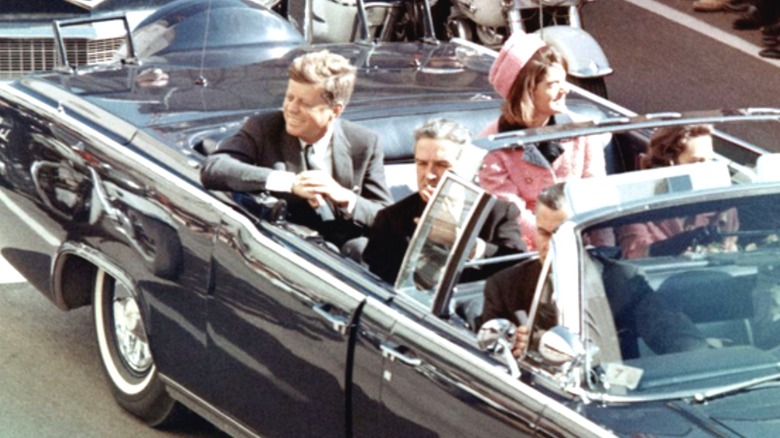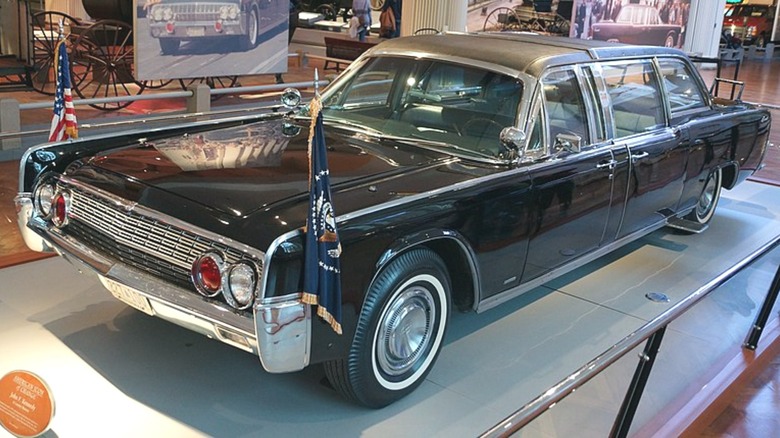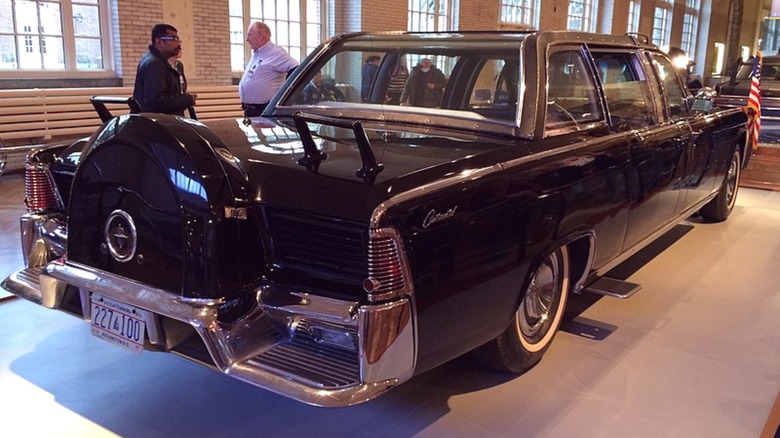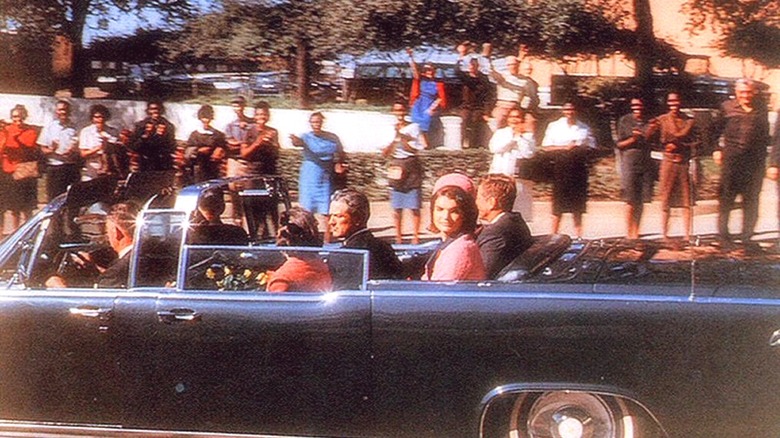What Happened To The Custom Limousine JFK Was Assassinated In?
The assassination of President John F. Kennedy on November 22, 1963, is one of the darkest events of modern American history. While campaigning in Dallas, Texas, President Kennedy rolled down into Dealey Plaza at 12:30 pm in his presidential limousine, a 1961 Lincoln Continental four-door convertible. The top was down, and as the President and First Lady waved to cheering onlookers, Lee Harvey Oswald shot him from the Texas School Book Depository.
Oswald managed to get off three shots, hitting the President twice and Texas Governor John Connally once. Kennedy was rushed to the hospital but was declared deceased shortly after. It's a dark moment, to be sure, and plenty of reporting covered the event, the shooting, the aftermath, and the investigation. While most Americans know at least the minor details of what happened, one thing that's typically left out of the story is the fate of the car.
After all, the presidential limousine was technically a crime scene, and because it was such an important vehicle in American history, it's odd that folks don't know much about it. The car itself was modified for presidential use, but it wasn't exactly special in and of itself. Still, given what happened to its occupants and how it impacted the entire nation and the world, the story of JFK's presidential limousine is one that every American citizen should learn.
[Featured image by Walt Cisco via Wikimedia Commons | Cropped and scaled | Public Domain]
President Kennedy's modified presidential Lincoln
President Kennedy's Lincoln wasn't purchased off the showroom floor and made good to go — it required several modifications. These were made so the car could be used for Kennedy's motorcade, so in addition to being a 1961 Lincoln Continental, many upgrades were added to the vehicle the Secret Service called "X-100." The car's roof came in three configurations, including the ability to remove it as was done in Dallas.
The X-100 also featured a rear seat, which could be raised by 10.5" to elevate the president. Additionally, it had additional steps added for Secret Service agents, who could stand upon them while holding onto special handles. The X-100 was also outfitted with flashing lights and a siren, as well as two radio telephones for communications, which wasn't exactly a standard feature in cars in the early 1960s.
Other modifications included various aesthetic changes to the grille and wheel covers, but at the end of the day, it was the added presidential seals and flagstaffs that made the X-100 look truly presidential. Essentially, the biggest flaw in the car's design stemmed from its removable roof, which might have saved President Kennedy had it been installed on that fateful day. Ultimately, it was Kennedy's decision to remove the roof so he could wave to his supporters.
[Featured image by Greg Gjerdingen via Wikimedia Commons | Cropped and scaled | CC BY 2.0]
What happened to Kennedy's Lincoln?
Kennedy's Lincoln was a crime scene, so it was impounded for evidence after the assassination. The car was dutifully examined throughout the investigation, and once that was complete, the plan was to modify it in Cincinnati, Ohio, before returning it to Washington, D.C., because the Secret Service felt it would be easier and less expensive to return the X-100 to service than build another car. A month after the assassination, Project D-2 was formed for this purpose, bringing in people from multiple organizations.
The White House signed off on Project D-2, which began in mid-December 1963 and was completed on May 1, 1964. The newly-modified X-100 underwent significant testing to ensure it met performance standards, and it was delivered to the White House in June of that year. Initially, the car cost around $200,000, but Project D-2 cost more than $500,000, as the enhancements were significant.
The new and improved presidential limousine featured additional armor, a permanent roof with transparent armor, an improved engine, a second air conditioner, new electronic communication devices, and reinforced components. The team cleared out the damage caused during the assassination, and an upgraded paint job was described as "regal Presidential Blue Metallic with silver metallic flakes that glitter under bright lights and sunshine" by a 1964 report by Willard C. Hess.
[Featured image by Chris Short via Wikimedia Commons | Cropped and scaled | CC BY-SA 2.0]
Further enhancements and retirement of the presidential limousine
The presidential limousine continued operating for the White House for several years, and in 1967, it was time for another upgrade. Project R-2 was initiated in January 1967 and included several modifications. The air conditioning unit was updated once more, ensuring better operation with an increased cooling capacity. Additionally, the right rear door received added specialized armor and glass.
The car also received an overhaul, so all of the panels were stripped down to the frame so any dents could be repaired, while the panels all received new paint. Another addition included the installation of additional roof-mounted handles for Secret Service agents. The cost of Project R-2 isn't clear, but it wasn't the last time the vehicle received upgrades. Over the next decade, the limo was modified to include technological improvements.
The car continued to serve the White House for a decade, ferrying Presidents Johnson, Nixon, Ford, and Carter until it was retired in 1977. The car now resides at the Henry Ford Museum in Dearborn, Michigan, where it is available to be seen by the public. While it was used by five U.S. presidents, the car remains an important one in the history of the nation for its part in the assassination of the 35th President of the United States of America.
[Featured image by Robert Croft via Wikimedia Commons | Cropped and scaled | Public Domain]



